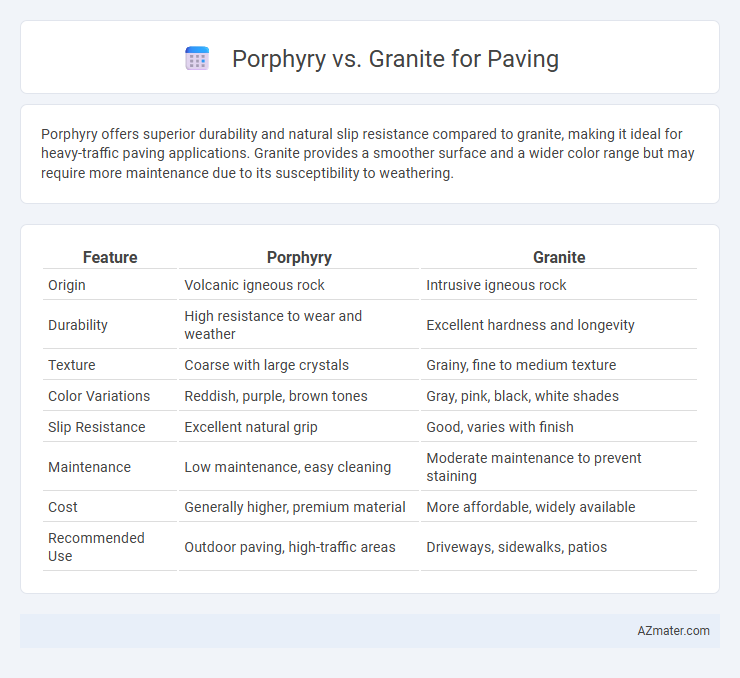Porphyry offers superior durability and natural slip resistance compared to granite, making it ideal for heavy-traffic paving applications. Granite provides a smoother surface and a wider color range but may require more maintenance due to its susceptibility to weathering.
Table of Comparison
| Feature | Porphyry | Granite |
|---|---|---|
| Origin | Volcanic igneous rock | Intrusive igneous rock |
| Durability | High resistance to wear and weather | Excellent hardness and longevity |
| Texture | Coarse with large crystals | Grainy, fine to medium texture |
| Color Variations | Reddish, purple, brown tones | Gray, pink, black, white shades |
| Slip Resistance | Excellent natural grip | Good, varies with finish |
| Maintenance | Low maintenance, easy cleaning | Moderate maintenance to prevent staining |
| Cost | Generally higher, premium material | More affordable, widely available |
| Recommended Use | Outdoor paving, high-traffic areas | Driveways, sidewalks, patios |
Introduction to Porphyry and Granite
Porphyry features a durable, fine-grained texture with large, distinctive crystals embedded in a dense matrix, making it an ideal choice for paving due to its natural slip resistance and aesthetic appeal. Granite, composed mainly of quartz and feldspar, is a hard, coarse-grained igneous rock known for its strength and ability to withstand heavy traffic and weathering in paving applications. Both materials offer exceptional longevity, but porphyry's unique crystal formation provides a distinctive look compared to granite's more uniform grain structure.
Geological Origins and Composition
Porphyry originates from volcanic activity, characterized by large feldspar crystals embedded in a fine-grained matrix, resulting in exceptional durability and low porosity ideal for paving. Granite, an intrusive igneous rock formed deep within the Earth's crust, consists mainly of quartz, feldspar, and mica, providing a coarse-grained texture and high compressive strength. The geological differences influence their wear resistance and aesthetic appeal, with porphyry's crystalline structure offering superior slip resistance compared to the more uniform grain of granite.
Visual Appearance and Color Variations
Porphyry offers a distinctive visual appeal with its coarse-grained texture and rich, earthy color palette ranging from deep reds to purples, providing a more vibrant and unique aesthetic compared to granite. Granite features a smoother, granular texture with a broader spectrum of colors, including whites, grays, blacks, and pinks, allowing for versatile design options in paving. The color variations in porphyry tend to be more uniform within each stone, while granite's speckled patterns create a dynamic, natural look that enhances outdoor spaces.
Durability and Weather Resistance
Porphyry offers superior durability and exceptional weather resistance compared to granite, making it ideal for high-traffic paving areas. Its dense, fine-grained texture resists frost, wear, and chemical damage better than granite, which can be more porous and prone to weathering over time. Porphyry's ability to maintain structural integrity in extreme climates ensures longer-lasting, low-maintenance paving surfaces.
Slip Resistance and Surface Texture
Porphyry offers superior slip resistance compared to granite due to its natural rough texture and high coefficient of friction, making it ideal for paving in wet or high-traffic areas. Granite's smoother surface can become slippery when wet, posing a higher risk of slips and falls, though it provides a polished aesthetic appeal. The coarse, uneven surface of porphyry enhances grip and safety, making it a preferred choice for outdoor paving with demanding slip resistance requirements.
Installation Techniques and Ease
Porphyry offers greater ease of installation for paving due to its uniform size and natural slip resistance, reducing the need for additional surface treatments. Granite requires more precision cutting and leveling during installation to address its varied grain and hardness, often increasing labor time and costs. Both materials benefit from skilled masons, but porphyry generally allows for faster and more straightforward laying processes.
Maintenance Requirements
Porphyry paving requires minimal maintenance due to its natural hardness and resistance to weathering, making it ideal for long-lasting outdoor surfaces. Granite, while also durable, tends to need more frequent cleaning and sealing to prevent stains and maintain its polished appearance. Both materials benefit from occasional sweeping and pressure washing to preserve their aesthetic appeal and structural integrity.
Environmental Impact and Sustainability
Porphyry offers a more sustainable option for paving due to its natural durability and lower maintenance needs, reducing resource consumption over time compared to granite. Its extraction and processing generally have a smaller carbon footprint, often involving less energy-intensive quarrying techniques. Porphyry's long lifespan and resistance to wear minimize replacement frequency, contributing to reduced environmental impact in sustainable paving projects.
Cost Comparison
Porphyry paving is generally more expensive than granite due to its unique volcanic origin and limited availability, which increases extraction and processing costs. Granite offers a cost-effective alternative with abundant deposits and easier quarrying methods, making it a popular choice for large-scale paving projects. Budget considerations often favor granite for its durability and lower installation expenses while porphyry provides a premium aesthetic at a higher price point.
Best Applications for Porphyry and Granite Paving
Porphyry paving excels in high-traffic outdoor areas due to its exceptional durability, resistance to weathering, and natural slip resistance, making it ideal for plazas, driveways, and pedestrian zones. Granite paving is best suited for spaces requiring a combination of strength and aesthetic versatility, such as patios, pathways, and commercial landscaping, owing to its dense composition and variety of colors and finishes. Both stones offer longevity and low maintenance, but porphyry's hardness makes it preferable for heavy-duty urban infrastructure, while granite provides more design flexibility for residential and decorative applications.

Infographic: Porphyry vs Granite for Paving
 azmater.com
azmater.com